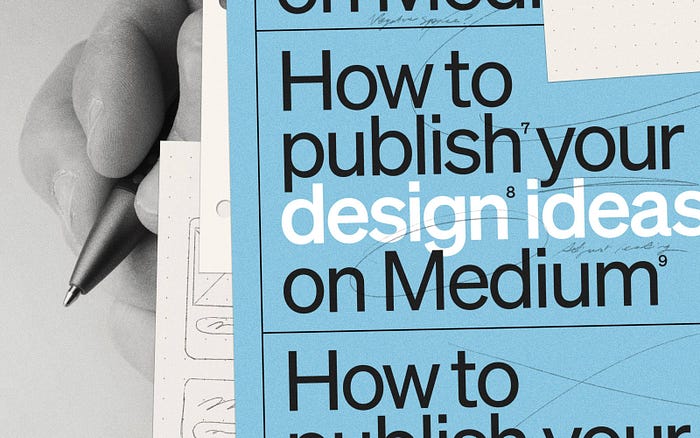How to publish your design ideas on Medium
Tapping into a community of designers who love to write and writers who love to design.

So, you’re a designer. You make things clear. Make things beautiful. You wrestle with complex challenges for brands and users; you spend your days immersed in pixels, prototypes, and problems that need solving.
How about words?
Not just the microcopy you use in your designs — real thoughtful, long-form writing. That’s certainly a tool you should consider adding to your stack.
For me, the journey with writing began nearly two decades ago, back when I was just getting started in design. My head was full. Too full, maybe. You know how it is when you’re learning a ton of new stuff — exciting, but overwhelming. Writing was how I untangled it. It became my way to capture those insights, to make sense of them, and solidify them in my own mind. It started as a personal practice, a way to document my growth, but it quickly evolved into a consistent habit that has profoundly shaped my career in ways I could have never imagined it would.
That simple act of regularly putting my thoughts and experiences into words, and connecting with a broader community through that writing, has opened up so many doors throughout my career. It’s led me to meet countless inspiring people from all over the globe, brought unexpected invitations to speak at conferences, and has been instrumental in helping me find and hire many of the talented designers I work with today.
And Medium has obviously been a big part of that over the years.
If you’ve heard of Medium but aren’t quite sure what it is, or more importantly, what it can do for you as a designer, you’re in the right place. This isn’t just another platform to scroll through endless feeds; this is a space where you can build your brand, connect with your peers, sharpen your skills, and share your unique perspective. Let’s dive in.
What exactly is Medium and how does it work?
Medium is a platform for people with good ideas to share. While the rest of the internet keeps getting busier and louder year after year, Medium feels like a quiet place — a place for longer-form writing and deeper reflection.
Here’s the gist:
- Anyone can write: From seasoned industry leaders to those just starting out, Medium is open to all voices.
- It’s all about discovery: Medium uses a combination of human curation and algorithms to surface interesting stories to readers based on their interests and reading history.
- Publications: These are like specialized magazines within Medium. Many are run by individuals like myself (with the UX Collective), while others are official blogs for major companies (think Microsoft Design). Getting your work and writing into a relevant publication can significantly boost your visibility.
For designers, this means you have a built-in audience who is interested in design, tech, and creativity, and a platform designed to make your thoughts reach others.
Why should designers bother writing on Medium?
You’re busy. You’ve got actual design work piled up. Why add writing to the mix? The benefits may change depending on where you are in your career, but here are a few:
Building your portfolio beyond the pixels:
- For early-career designers: Writing about your process, the thinking behind your design choices, or even a full case study may add another dimension to your portfolio. It demonstrates your ability to articulate your ideas, a crucial skill for any designer. Think of it as the “director’s commentary” for your design work.
- For more senior designers: You’ve got a wealth of experience but you might not be able to talk publicly about your work due to non-disclosure agreements, or you might simply lack the time to put together a full portfolio. Writing allows you to share your expertise and thought leadership on an ongoing basis while staying connected with the broader design community.
Building community:
I’ve lost count of how many great designers I’ve met because of the Medium community. Writing and publishing your thoughts can create opportunities to find mentors, collaborators, or even land your next job opportunity. Your journey into design, your career pivots, the lessons you’ve learned — these are stories only you can tell, and they can inspire and guide others.
Sharpening your craft:
Writing is a powerful tool for professional development — it’s a secret weapon most designers don’t use enough. The act of writing forces you to clarify your thoughts. Explaining a complex design decision or a research finding helps you understand it better yourself. This skill translates directly into better design presentations and stakeholder communication.
Advocating for what matters:
Design isn’t monolithic. Your background, experiences, and passions shape your design philosophy. Medium is a place to share that — whether you’re passionate about accessibility, inclusive design, sustainability, or any other topic that’s meaningful to you.
Navigating publications
On Medium, you’ll find everything from tactical UI tips, tooling how-tos, to high-level design strategy. And a key part of what makes this ecosystem special is Publications. Think of them as curated collections of articles around specific themes.
There are a few benefits of getting your work accepted by existing publications on Medium. Publications already have an audience (often a bigger and more specific one than yours), which means your work gets in front of more of the right eyeballs, faster. Plus, when a respected publication gives your writing the nod, that sends people a positive signal about your work. And often, their editors are pretty good at making sure stories get seen, doing a lot of the promotional heavy lifting for you.
For designers, there’s a rich variety of pubs on Medium:
- Broad design publications: These cover a wide range of design topics (e.g., UX Collective, UX Planet, Bootcamp, UX Magazine, Prototypr, Web Designer Depot, Design Nexus, Signifier). They often have large readerships and are great for general design articles.
- Niche publications: Focused on specific areas like UX research, UX writing, service design, or topics adjacent to the field of design (e.g., Entrepreneurship Handbook, Data And Beyond, Women in Technology, Better Marketing, The Writing Cooperative).
- Company-specific design blogs: This is a fascinating aspect of Medium. Many leading tech companies (e.g., Adobe Design, Microsoft Design, Lyft Design, Vanguard Creative, Wix UX, or even Medium Design) host their official design blogs on Medium. They use it to share their design culture, processes, case studies, and attract talent.
Before you pitch your story to a publication, read the type of content they run. Does your article make sense for them? Look for their submission guidelines — usually a “Write for Us” or “Contribute” page. Then, make sure you’re sending them a solid, polished piece. Publications can be an incredible way of connecting with a broader audience on the platform.
How to get started: what should you write about?
The blank page can be daunting. Here are some ideas to get your gears turning:
- Your process: Walk through a recent project (with permission, of course). What were the challenges? How did you approach them? What were the outcomes?
- A tool or technique you love (or hate): Did you just master a new Figma feature? Have strong opinions on a particular research method?
- A lesson learned: Reflect on a mistake or a surprising insight from your design work. It’s ok to talk about your failures and what you learned from them.
- A trend you’re seeing: What is an observation you made that you haven’t seen many people talking about? And how can you back that up with real data and insights?
- A how-to guide: What are some tips and tutorials you can share on how you get work done? These can be extremely helpful for designers who are starting now in their careers.
- A case study: What’s a project you’ve done that you’re really proud of, and that you think is worth documenting?
- Book reviews or conference recaps: Share key takeaways from design books you’ve read or an event you attended.
The key here is to start small. You don’t need to write a magnum opus for your first article. A 300–500 word piece on a focused topic is a great way to begin.
And don’t forget the visuals: as designers, we know the power of a well-chosen image or a clear screenshot. When writing for an audience of your peers, incorporating visuals isn’t just a nice-to-have, it’s essential. Add images, diagrams, mockups, or even short prototypes of the experiences or concepts you’re describing. This makes abstract ideas more tangible, breaks up text, and helps readers more easily assimilate your points. Think of it as showing, not just telling.
If you’re not sure where to start, reading on Medium is a great way to get inspiration — here’s some of my favorite recent stories from UX Collective.
Staying human in the age of AI
With the rise of AI writing tools, the value of your actual voice, your real stories, your screw-ups, and your wins are even more valuable. The need for genuine human perspectives has never been higher.
Lean into what makes your voice uniquely yours. The projects that went sideways. The late nights. What it felt like. That’s the stuff a robot can’t make up. Let your personality shine through, whether you’re witty, analytical, or passionately expressive.
Focus on providing nuance and critical thinking that goes beyond surface-level observations; explore the grey areas, ask tough questions, and weave your insights into real-world examples, even allowing for a bit of vulnerability.
Your design voice matters
Medium offers a pretty unique platform for designers to step beyond their design tools and share their thoughts, learnings, and career stories with a global community. Just as writing helped me capture and understand the whirlwind of new ideas when I first started in design all those years ago, it can do the same for you.
Take that leap. Open up that new draft.
Find that one topic that’s been quietly buzzing in the back of your mind, the one that makes your heart beat a little faster. Your voice, your unique experiences, your individual way of seeing the world as a designer — it’s time to let your voice be heard.

